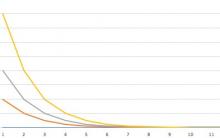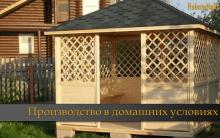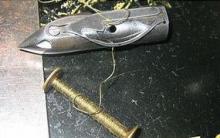K category: Stone cladding
Extraction of blocks from granite and related rocks
Blocks of granite and related igneous and metamorphic rocks are mined in ledges using drilling and blasting and borehole methods.
Ledges are developed sequentially from top to bottom at the same time one or two ledges. Ledges with a thickness of 3 to 6 m are divided into sub-ledges, taking into account the horizontal fracturing of the massif. The height of the substeps is determined by the distance between the horizontal cracks of the array; with the buroklin method of block mining, it should be no more than 1.5 m.
With the method of borehole charges of drilling and blasting, the ledge height reaches 10-20 m.
The width of the working platform on the ledges is at least 3 m, and on the ledges, where splitting of monoliths into blocks and their passaging is planned, it is from 20 to 50 m. The length of the work front is from 50 to 150 m.
The most important process in the technology of mining granite blocks is the puncturing of large monoliths from an array, the dimensions of which depend on the distance between individual cracks, and in their absence, on the carrying capacity of lifting and transport equipment.
Effective work the quarry is achieved when the monoliths are punched out of the massif in the presence of three exposed planes.
Depending on the structure, texture, physical and mechanical properties of the rock and the degree of its fracturing, as well as on the value and purpose, monoliths are chipped out of the massif in one of the following ways: drilling and blasting using black powder; buroklinovym with the placement of wedges in boreholes, nests or natural cracks; drilling with drilling along the split lines of a continuous row of holes; thermal (using thermal cutters); combined with the use of thermal cutters and drilling or blasting methods.
The monolith separated from the array is moved by a tractor from the face to a distance of at least K) m and split into blocks and blanks of given sizes.
The monolith is split, as a rule, by the boring method with the placement of wedges in nests formed by pneumatic jackhammers, or in holes drilled by perforators.
The bore-wedge method with the placement of wedges in nests is used at a monolith height of up to 1 m in rocks capable of splitting along relatively flat planes. The monolith is split as follows. First, along the marked planes, using a pneumatic jackhammer with a removable tip in the form of a tongue or scarpel, a guide groove with a depth of 10-15 mm is cut along the splitting line. Then, in the furrow, after 150-200 mm, with a jackhammer using a scarpel or a groove, conical nests of oval section with a depth of 30-50 mm are made. Such a section of the sockets contributes to the reliable contact of the wedge with the rock and the concentration of stresses for splitting the rock in a given direction. With a hammer blow, simple wedges up to 100 mm long are hammered into the nests.
The bore-wedge method with the placement of wedges in boreholes is used when splitting a monolith from any rock.
To get blocks High Quality, observe the following the necessary conditions: splitting lines are planned parallel to the prevailing fracturing; choose the depth of holes and the distance between them, providing the lowest specific consumption of drilling; the holes are placed in the plane of the planned splitting, for which they use templates made from a steel angle or wooden board with holes corresponding to the distance between the holes; types and sizes of wedges are determined depending on the physical and mechanical properties of the rock; the diameter of the hole is chosen in accordance with the type and size of the wedges.
When splitting blocks of cross-layered rock and harvesting plates up to 150 mm thick, through drilling of holes is carried out, regardless of the height of the monolith.
The distance between the boreholes is specified in the course of work, depending on the ease of splitting the stone, the direction of the split attributable to the stump of the layering and the line of the best split.
With a monolith height of more than 1000 mm, depending on the properties of the rock, drilling is used: multilateral - with small holes, one-sided - with small holes in combination with deep (0.75 monolith height) holes or one-sided for the entire height of the monolith.
The passivation of blocks made of granite and rocks close to it includes: chipping off large pieces along the edges of the block, forming sharp corners; chipping of individual protrusions; gradual bringing the block to standard sizes.
Blocks are passed by impact processing with pneumatic jackhammers and reinforced tools hard alloys. Rocks that are thermally cut out of the massif are treated with thermal breakers operating on a gasoline-air or oxygen-kerosene mixture.
- Extraction of blocks from granite and rocks close to it
Let's take a virtual tour of a small granite quarry located in the north of the Leningrad region to take a look at the process of mining this rock in conditions of maximum cost savings finished products.
The quarry is hidden from prying eyes, hiding in remote places almost on the border with Finland. There is a road, but it is rather difficult to call it a road. More like a direction. A bumpy primer stretching about forty kilometers from Kamennogorsk to the quarry took us more than an hour. Each new kilometer was worse than the previous one, until, finally, the road turned into a continuous sandy-clay mess. True sign. So we're almost there.
At first glance, the quarry looks abandoned. We didn't meet a single person at the entrance. But nothing surprising. Due to the difficulties of winter mining, the management of this open pit decided not to develop in winter period. With the onset of frost, work here completely stops until spring. Now in April, the reactivation of production after the winter stagnation has just begun. The first watch arrived here just a week ago. We must immediately make a reservation that this quarry itself is quite small and it is difficult to call the extraction of blocks here industrial. The volumes are very modest and average 180-200 m3 of finished blocks per month, which is several times less than in a similar quarry in the neighborhood.

Living conditions here are Spartan. There is no electricity. All electricity is supplied by a diesel generator. Everything else is like in the countryside. Water in the well, toilet outside, shower in the same place. Heating stove. The harsh life of harsh stonecutters.

The picture of brutality is complemented by a battered domestic-made bulldozer, like a dormant monument near a residential town. There isn't much work for him here.

The senior of the current shift told us about the career and the nuances of work, who kindly agreed to conduct a short tour of his household. Only 5-7 people per shift. Almost all employees have universal skills and combine several positions. They are trying to increase the profitability of production at existing volumes by reducing costs, including savings on staff. The mining foreman here acts both as the head of the site and as a power engineer. The loader operator can be a splitter, a saw operator, and a mechanic.

The warehouse of finished products at the beginning of the season looks rather modest. The quarry does not perform any processing other than direct mining. These granite blocks are what goes on sale. There are no clear sizes for blocks, which would be extremely difficult and costly to withstand. Therefore, there are categories or groups. According to GOST, 4 groups of blocks are defined. I group - blocks over 5 m3, II group - blocks 3-5 m3, III - 0.7-3 m3, IV - 0.1-0.7 m3. Blocks should have a shape as close as possible to a parallelepiped. There may be deviations from the correct form, but they are strictly regulated. The value of a block depends on its size. The larger the volume of the block, the greater not only its cost, but also the greater the cost of one cubic meter. For example, the cost of 1 m3 of granite block Group III in the warehouse - 25,000 rubles, and the block of group I will already cost 28,000 rubles per 1 m3.

However, despite the more expensive cost, large blocks are not very profitable to mine. Blocks II and III of groups are in the main demand. Such as for example this one. This is a classic example of the most sought after block in this career. Its size is approximately 1x1x2.5 meters.

However, among the finished blocks there are also such giants. It is not known how long such a block will wait for its buyer, but sooner or later it will happen and it will be a profitable sale. Such large blocks are usually taken for subsequent cutting into slabs - plates, from which, for example, countertops or window sills are then made. But this product is not very popular. Much more often, granite is used to make facing tiles, curbstones or slabs for paving pavements and sidewalks. For these products, such a size of raw blocks is simply not needed.

Therefore, in most cases, mined large blocks are passered to give them more popular dimensions and the correct shape. For this, special drilling equipment is used, which is capable of very quickly, and most importantly, accurately drilling a line of parallel holes, along which the block will later be split into pieces. There is also a more technologically advanced method - sawing, but in terms of mobility, the "drill" wins, although it is noticeably inferior in speed and quality. After a circular saw, the edges of the block acquire smooth, even surfaces, which positively affects its commercial qualities.

There are different technologies for mining blocks. The most common mining in our country until recently was the method of weak explosions. But it has many shortcomings. With this method of mining, a huge amount of waste is obtained, reaching 80% of the resulting rock mass. In addition, an incorrect calculation of the power of the explosion can lead to the appearance of cracks, which is why such a stone will simply be of no use to anyone. Thus, it is possible to ruin the deposit altogether and the only product that can be obtained will be only crushed stone. Therefore, the method of rope sawing is becoming more widespread. The design of a wire saw is very simple. In fact, this is an electric motor that pulls a rope that is remotely similar to a bicycle chain with cutting diamond elements.

It is after her work that such perfectly even and smooth walls remain. But not everything is as simple as it seems at first glance. If there is nothing complicated in the sawing process - the saw cuts on its own, gradually moving along the rails as it cuts, then the preparation process is much more laborious.

In order to get the rope, you must first drill two holes in the rock. One is vertical and the other is horizontal. and they need to be drilled in such a way that they intersect at one point. The slightest distortion of the drill and drilling will go down the drain. For this operation, many devices have been developed around the world to make life easier for miners, but this quarry has traditionally been trusted with a hand-held portable air-driven drilling rig.

It drills granite rock very effectively, but it has its own characteristics. It needs a compressor to work. It is good if there is a diesel compressor. It can work autonomously. And if the compressor is electric, then you will either have to pull wires with power supply to it, or power it from diesel generator. Such a scheme is just used in a career. As you remember, there is no external power supply here. As you drill, the length of the drill has to be increased. This is done using drill pipes, which, in addition to lengthening, also provide air supply.

Perhaps the main disadvantage of such a drilling tool is its inaccuracy. According to the workers themselves, the hardest part of wire sawing is precisely drilling holes. It turns out, alas, not always. Sometimes you have to re-drill, often more than once. If everything went smoothly, a cutting rope is inserted into the holes obtained and then it is enough to look after the saw while it saws off a piece of rock.

They are sawn in vertical slices called panels. After the cut is completed, the panel is filled up. From hitting the ground, it usually splits along natural cracks. After that, the resulting blocks are sorted and given them a commodity form.

Panel collapse is perhaps the most dangerous procedure in the entire block mining process. The higher the horizon, the more dangerous. The panel is filled up with the help of a loader. A chopper is inserted into the cut from above - a steel hook. A cable is attached to it, a loader is hooked at the other end and slowly begins to pull. At some point, the rock breaks down and collapses. I don't want to be around at this moment. By the way, the risk of involuntary self-filling of the sawn-off panel also exists. Therefore, you must be extremely careful and avoid potentially dangerous areas.

Fracturing - main enemy miners. If there are many cracks, then the percentage of waste increases accordingly. Fragments of irregular shape, with the wrong direction of the layering of the stone, too colorful pattern, etc. go to waste. However, the concept of waste in this case is rather abstract. If desired, almost all of this waste can be recycled accordingly. For example, split it into small items, such as paving stones. Another question is how useful it is. Here each quarry solves this problem independently.

The main machine in the block pit is undoubtedly a huge front loader. It is he who does all the hard work in the career. Thanks to its strength and weight, it is an indispensable assistant to a person in almost all operations, from clearing the face of waste, transporting blocks, to filling up panels. The most common loader for this type of quarry is the CAT 988. This is a huge machine weighing 50 tons, incredibly strong and reliable. Such a unit has simply a cosmic cost - about 800,000 dollars. One tire alone from such a loader costs about $10,000.

As I already said. This machine does absolutely everything. With its help, finished blocks are moved to the warehouse, the face is cleared of debris, fuel is delivered to installations at any point in the quarry, loading onto vehicles is carried out, access roads are backfilled and leveled, snow is removed.

The loader does not use a bucket to move and load blocks. For these operations, there is another device - a pitchfork. The loader is equipped with a quick-detachable device that allows you to quickly change attachments. It only takes a couple of minutes for a bucket wheel loader to turn into a forklift like the one we often see in large hardware stores. Only more, much more.

Forks, by the way, are also solid. To match the car itself. They have to lift the weight up to 20 tons. But sometimes the blocks weigh more. For their transportation, standard cargo semi-trailers are not suitable. They are transported on reinforced platforms, on which heavy cargo is usually transported. construction equipment, and loading is carried out already with the help of a crane.

And this is how the very waste from the production of blocks looks like: fragments, fragments and trimmings, which in their shape and size do not fall into any group. Domestic quarries traditionally do not care about recycling their waste, which is actually an excellent raw material. But this requires appropriate equipment, which is very expensive. In addition, this is a completely different profile and a different sales market. It is simply not profitable for the quarries themselves, and it is unprofitable for stone processors to transport fragments to their production facilities. Because of this, the dumps of long-standing quarries reach incredible sizes. Sometimes they accumulate several million cubic meters of rock.

The stone mining business in Russia is only now beginning to enter the path of high technology. Increasingly, high-tech machinery and equipment are being used, more efficient technologies, there are additional shops for processing stone. Of course, such a development directly depends on the leadership and, unfortunately, in our country it often happens that the current state of affairs suits many. However, this situation is not limited to the mining industry.

Today, Mining Administration Vozrozhdenie is one of the largest companies for the extraction of block building and decorative stone in Russia. Offering partners and customers only excellent high quality products, we have established ourselves as a good manufacturer, quality supplier and reliable partner.
Sale of granite blocks
For many decades, mining and stone processing has been the main activity of our company. We strive to constantly increase the physical volume of production, and we are constantly working to improve the quality of our granite blocks. This helps us:
- Own rich practical experience
- Application of mining best practices natural stone foreign colleagues
- Use of powerful production technology
- Modern tools and consumables
We have our own stone processing plant and comply with GOST requirements for natural stones. Our product is great for cladding and erecting walls and fences, creating steps and much more.
At our fields, blocks of the correct geometric shape with a volume of up to 5 m3 or more are produced (depending on the needs of the customer).
We use high-tech equipment of domestic and foreign production. Quarry works are carried out using:
- loaders Volvo, Caterpillar
- self-propelled drilling rigs Tamrock, Marini, Stone Power
- diamond wire sawing machines Pellegrini, Benetti, Toolsstar
- self-propelled hydro-wedge installations, etc.
Timely delivery of products is ensured by the developed transport infrastructure of the region. Our own loading areas for road or rail transport allow us to transport stone to any of the regions of the Russian Federation.
We work without intermediaries and offer our customers to purchase blocks from the manufacturer at a bargain price. And thanks to the unique border location of the deposits, we have the opportunity to organize flexible logistics for the supply of products for export by all modes of transport with customs clearance in Vyborg.
Extraction of natural stone in our own quarries!

Vozrozhdenie deposit
The Vozrozhdeniye deposit has been developed for more than 100 years and is perhaps the largest and most developed not only in the northwestern region, but throughout Russia. The area of the quarry is 35 hectares. Explored reserves are 8,082.0 thousand m 3 .
All over the world, industrial extraction of natural stone - granite and marble is actively carried out. Countries such as Brazil, Greece, Italy, Spain and Norway were clear leaders in this industry until recently, but today, thanks to a serious leap in development, the main focus of the extraction of granite and marble raw materials for the production of stone products has shifted to Asia, and especially in India and China.
The technology of mining blocks for the production of granite products is fundamentally different from the methods of mining other solid minerals, the main task of which is to destroy the natural integrity of the rock and bring it to a certain fraction, convenient for further processing. During the extraction of granite and marble blocks, it is necessary to preserve the natural solidity and integrity of the stone. Based on this, the entire procedure, from the extraction of granite blocks and subsequent transportation to storage and installation on stone processing equipment, should be as careful as possible, since any negligence leads to damage or loss of quality, integrity and strength of the stone block, which in the future is very serious. affects its processing and the quality of finished products.
Also, the quality of natural stone is greatly influenced by the method of extraction. Granite stone is mined in four main ways and the quality of the resulting stone directly depends on which method was used:
The explosive method - one of the most common and outdated methods - is mining using a directed explosion. The extraction of granite by this method occurs as follows: deep holes are drilled in the granite rock (to the depth of the future granite block) and a charge is inserted, while calculating the force and direction of the explosion so as not to damage the main natural solidity, and undermine. Among the exfoliated parts of the rock, the largest parts are selected, after which they are transported to sawing for granite slabs and other products. The only positive aspect of this method of extracting granite is that it is the cheapest. Accordingly, this affects the cost of granite products. But there are much more disadvantages with this type of production. Firstly, the quality of the extracted natural stone deteriorates significantly, microcracks appear in the very structure of the granite rock, which greatly affects the strength of the finished granite products. Secondly, this method is irrational for the reason that during an explosion, no matter how the demolition workers try to calculate the mass of the explosive, the bulk of large blocks that are suitable for further use for the manufacture of products from natural stone does not exceed 60% of the total mass of the extracted natural stone. stone. The rest, which is more than 30%, goes to waste.
The chipping method is the next most common method of extracting natural stone. It is similar to the first method in that holes are also drilled in the rock along the contour of the future block, but instead of explosives, air tanks are placed in the holes, into which air is pumped under high pressure. This method is more accurate in relation to granite rock, as it is a gentle mining method and avoids unnecessary destruction in the solidity of the rock. This method makes it possible to use the granite deposit more fully, calculate the fault locations and avoid damage to the block, including even microscopic cracks. There are much more monoliths, and much less waste. Another one from good points With this method, it is a more accurate location of the rock break than when using an uncontrolled explosion, which gives almost 90% yield of the bulk of the rock for the manufacture of granite products. However, with this method of extraction, significant investments in mining equipment will be required, and the method itself takes much more time than explosive.
Buroklinovy method (Silent explosion method) - a method of mining blocks decorative granite, at which the contour of the stone block planned for separation is drilled. After that, mechanical or hydraulic wedges are introduced into the holes made, and at the end the necessary monolith is chipped off along the contour. In the silent explosion method, instead of wedges, mixtures that expand when solidified are used. However, this method has not received sufficient distribution in world practice due to its technological complexity.
Rock cutting (Stone Cutter Method) is the fourth method of extracting granite blocks, the most modern and gentle in relation to the deposit. It lies in the fact that the rock is not blown up or split, but cut into regular parallelepipeds of the required size. And this method is the most expensive, as it requires the purchase of very expensive stone-cutting equipment and staff training, but at the same time it is the best, allowing you to completely avoid damage to the main rock, and getting - perfect quality blocks of granite, without the slightest defects, both external and hidden. At the same time, the stone deposit is being developed almost 100%.
2016 © "Granite Technologies"
-=Prepared for the benefit of the My Street project=-
Today we'll talk about sawing ... Who and how saws for the My Street program. Meet the man in the photo, very similar to Vladimir Putin, and he is to blame for everything.
It was he and dozens of his colleagues in the Urals who mined granite almost around the clock, and then sawed, sawed and sawed. So that Muscovites have tiles under their feet!
Few people know, but thanks to a large-scale street reconstruction program, hundreds of jobs were created in Bashkiria: new industries appeared, new quarries began to be developed, and expensive foreign equipment was purchased.
Recently I went and saw how everything is going. Where tiles for Moscow are born.
The Mansurovsky granite deposit is located in the east of Bashkortostan (this is in the southern part of the Urals, if you are bad with geography). The easiest way to come here is from Magnitogorsk, which I did. The places are awesome. 
local villages 
The Mansurovskoye deposit is the largest in Russia for the extraction of light gray granite. It has been developed since the 80s. 
The granite mined here is considered unique because of its color and age. It was formed about 350 million years ago. This is one of the oldest granites on the entire planet. 
According to geologists, the proven reserves of the deposit will last another 200 years. All of Russia can be rolled into granite;) 
Granite is taken out of the quarry in the form of large rectangular blocks. The larger and smoother such a block, the more convenient it is to work with and the higher its cost. By the way, anyone can buy a granite block. 
But chipping away a good piece of granite is no easy task. Do not forget that granite is one of the most durable and dense materials. 
There are several methods for separating a granite block from a large mass. For example, you can cut off a large piece using large gas burners. The composition of granite includes quartz, which, under the influence of temperature, peels off and flies off. Due to this, the burner gradually cuts through the granite. The more quartz in granite and the larger its grains, and the faster the rock is cut. 
There is another way: along the line of the future fault, narrow deep holes are drilled in the monolith, which are called boreholes. Then in these holes are laid explosive faceted. It detonates relatively gently and thus separates a solid piece of granite from the monolith. 
You can also saw off a large piece of granite with a diamond wire. This option is more gentle, but it takes quite a lot of time. The rope is passed through the drilled holes, and then the installation is started, which begins to scroll it quickly. The scrolling speed is approximately 30-40 m/s. And in a few hours of work, the rope cuts through a smooth, neat cut in granite. 
So, a big piece has been sawn off, what to do next? Now it needs to be divided into smaller blocks so that they can be conveniently transported and processed. This is done by hand. Wedges are driven into the granite along the line of the future fault, and in the end the rock cracks and a smaller block is separated from the large piece. Splitting blocks in this way is very hard work. 
Finished granite blocks are taken to the workshops. There they will be sawn and processed. 
Here is one of the sawmills. It was built a year ago, just thanks to the program "My Street" 
The imported granite blocks are first of all sawn into slabs of the required thickness, depending on what they are going to produce. This can be done, for example, using a rope machine. All equipment here is new, it was bought under Moscow contracts 
Steel cables with diamond elements are scrolled very quickly in the machine. They fall lower and lower, gradually cutting the granite block into even slabs. 
In the process of sawing, the stone and cables are continuously poured with cold water. This is necessary for cooling and removing granite dust. 
On such machines, it is possible to saw blocks into 10 plates with a height of more than two meters. Please note that modern machines allow you to make not only even cuts, but also according to a given razius. Previously, in Russia they did not know how to do this. Now we have bought equipment and can cut, for example, curved curbs. 
The cuts are perfectly even. 
More blocks can be cut with the usual circular saw. In this case, the block is placed in the machine in the same way, and a saw with a dozen round disks starts to ride along it. 
This is a rather long process - in one pass, the discs descend only one centimeter deep into the granite stone. 
After sawing, the granite is sent for further processing. Now, facing and paving slabs, curbs and everything else will be cut from them. 
Granite is very dense and hard, so it does not crumble during cutting, and the edges are perfectly even. 

The saw blades and the granite itself are continuously poured with cold water. It washes away granite dust and cools the tool. 
Last cut. 
And it turns out beautiful and neat granite paving slabs. We have never done anything like this before in such volumes. 

Final processing. 
On the street, meanwhile, paving stones are made from scraps of granite blocks. 
It is made by hand, carefully cutting off the edges so that a piece of granite turns out to be a cubic shape of the desired size. Such paving stones are called chipped. 
By the way, Mansurovsky granite is the brightest of all types of granite that are mined in Russia. At the same time, it changes its color depending on the type of processing. When polished, it will turn slightly greenish, after spotting it will become white, and after fired it will become light gray. Granite is also processed to become rough. This is necessary, for example, on ramps. 
Here is the surface after processing. Not to slip in winter. 
Abroad, Mansurovsky granite is the most popular of all granites mined in Russia. Due to its light color, it is often compared to marble.
Granite processing enterprises are now developing quite steadily, and this is largely due to the 2014 crisis. Due to the jump in the dollar, it became very unprofitable to buy granite abroad, and therefore customers began to turn to Russian manufacturers, who offered prices almost two times lower. In the same way, Mansurovsky's career was also lucky. After the launch of the My Street program, granite production here doubled to 6,000 cubic meters per month. 
The money received from the first orders, the company decided to spend on the purchase of new equipment and the construction of additional workshops. The industry began to develop gradually, pulled up and related enterprises for the production of packaging, wire rod, wood, various equipment, etc. 
The workforce at the quarry also increased from 300 to 400 people. In general, the production of granite for Moscow now employs more than 4,000 people throughout the Urals. 
Many of you have probably seen Mankurov granite. It can be found on the streets of Novosibirsk, Salekhard, Tyumen, Irkutsk, Krasnoyarsk, Kazan, Astana, Baku and many others. There is also a lot of it in Moscow, especially on the reconstructed streets. In particular, it was laid on Tverskaya. In addition to it, 4 more types of granite from other Ural quarries are used. In total, the Ural quarries supply approximately 90% of all necessary tiles, curbs and paving stones to Moscow. The remaining 10% is brought from Karelian deposits. 
Like this. The next time you walk along Tverskaya, know that under your feet you have excellent Ural granite, which is already about 350 million years old.












Flower party: a bouquet of positive emotions
Words of teachers in a congratulatory scene for parents
Who's Who by Relationship Her mother-in-law calls her mother-in-law mom
Your mother is my mother-in-law Riddle mother-in-law calls my mother-in-law
How to make a scene for a wedding “Three girls under the window Comic scene three girls